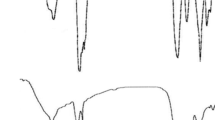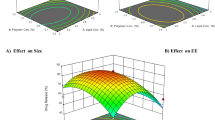Abstract
The present work aims to develop folate-targeted paclitaxel liposome (F-PTX-LIP), which will selectively target tumor cells overexpressing folate receptor (FR) and leave normal cells. Liposomes were prepared by thin-film hydration method followed by post-insertion of synthesized ligand 1,2-distearoyl-sn-glycero-phosphoethanolamine-polyethyleneglycol 2000-folic acid (DSPE-PEG2000-FA) on the outer surface of the liposome. The synthesized ligand was evaluated for in vivo acute toxicity in Balb/c mice. Developed liposomal formulations were characterized using transmission electron microscopy (TEM) and small-angle neutron scattering (SANS). We have investigated the effect of ligand number on cell uptake and cytotoxicity by confocal laser scanning microscopy (CLSM), competitive inhibition and 3-(4,5-dimethythiazol-2-yl)-2,5-diphenyltetrazoliumbromide (MTT) assay. Compared to lung adenocarcinoma cells (A549), uptake in human ovarian carcinoma cells (SKOV3) was 2.2- and 1.2-fold higher for liposome with 480 and 240 ligand number respectively. Competitive inhibition experiment shows that prior incubation of SKOV3 cells with free folic acid significantly reduced the cell uptake of F-PTX-LIP with 480 ligand number (480 F-PTX-LIP) by 2.6-fold. 480 F-PTX-LIP displays higher cytotoxicity than free drug and PTX liposome. Moreover, it specifically targets the cells with higher folate receptor expression. Optimized 480 F-PTX-LIP formulation can be potentially useful for the treatment of folate receptor-positive tumors.










Similar content being viewed by others
Abbreviations
- FR:
-
folate receptor
- PTX:
-
paclitaxel
- PTX-LIP:
-
paclitaxel liposome
- F-PTX-LIP:
-
folate-targeted paclitaxel liposome
- DSPE-PEG2000:
-
1,2-distearoyl-sn-glycero-3-phosphoethanolamine-polyethyleneglycol 2000
- DSPE-PEG 2000-FA:
-
1,2-distearoyl-sn-glycero-3-phosphoethanolamine-polyethyleneglycol 2000-folic acid
- PS:
-
particle size
- PDI:
-
polydispersity index
- ZP:
-
zeta potential
- % EE:
-
percent drug entrapment efficiency
- % DL:
-
percent drug loading
- TEM:
-
transmission electron microscopy
- SANS:
-
small-angle neutron scattering
- DSC:
-
differential scanning calorimetry
- CLSM:
-
confocal laser scanning microscopy
- MTT:
-
3-(4,5-dimethylthiazol-2-yl)-2,5-diphenyltetrazolium bromide
- F-LIP:
-
FR-targeted liposomes
- NF-LIP:
-
folate receptor-targeted liposomes with no ligand
- b-LIP:
-
blank liposome
- 240 F-LIP:
-
folate receptor-targeted liposomes with 240 ligand per liposome
- 480 F-LIP:
-
folate receptor-targeted liposomes with 480 ligand per liposome
- 240 F-PTX-LIP:
-
folate receptor-targeted paclitaxel liposomes with 240 ligand per liposome
- 480 F-PTX-LIP:
-
folate receptor-targeted paclitaxel liposomes with 480 ligand per liposome
- PEG:
-
polyethylene glycols
- SPC:
-
soya phosphatidylcholine LIPOID S100
- DCP:
-
dihexadecylphosphate
- DCC:
-
dicyclohexylcarbodiimide
- NHS:
-
N-hydroxysuccinimide
- TEA:
-
triethylamine
- DLS:
-
dynamic light scattering
- FTIR:
-
Fourier transform infrared
- PSD:
-
position-sensitive detector
- RPMI:
-
Roswell Park Memorial Institute
- 1H NMR:
-
proton nuclear magnetic resonance
- MFI:
-
mean fluorescence intensity
References
Singla AK, Garg A, Aggarwal D. Paclitaxel and its formulations. Int J Pharm. 2002;235:179–92.
Zhang Z, Mei L, Feng S-S. Paclitaxel drug delivery systems. Expert Opin Drug Deliv. 2013;10:325–40.
Kampan NC, Madondo MT, McNally OM, Quinn M, Plebanski M. Paclitaxel and its evolving role in the management of ovarian cancer. Biomed Res Int. 2015;2015:1–21.
Sgadari C, Toschi E, Palladino C, Barillari G, Carlei D, Cereseto A, et al. Mechanism of paclitaxel activity in Kaposi’s sarcoma. J Immunol. 2000;165:509–17.
Perez EA. Paclitaxel in breast cancer. Women’s Health. 2006;2:11–21.
Yoshizawa Y, Kono Y, Ogawara K, Kimura T, Higaki K. PEG liposomalization of paclitaxel improved its in vivo disposition and anti-tumor efficacy. Int J Pharm. 2011;412:132–41.
Yang T, Cui F, Choi M, Cho J. Enhanced solubility and stability of PEGylated liposomal paclitaxel: in vitro and in vivo evaluation. Int J Pharm. 2007;338:317–26.
Gelderblom H, Verweij J, Nooter K, Sparreboom A, Cremophor EL. The drawbacks and advantages of vehicle selection for drug formulation. Eur J Cancer. 2001;37:1590–8.
Szebeni J, Muggia FM, Alving CR. Complement activation by Cremophor EL as a possible contributor to hypersensitivity to paclitaxel: an in vitro study. J Natl Cancer Inst. 1998;90:300–6.
Gogaté US, Schwartz PA, Agharkar SN. Effect of unpurified Cremophor EL on the solution stability of paclitaxel. Pharm Dev Technol. 2009;14:1–8.
Maas B, Huber C, Krgmer I. Plasticizer extraction of Taxol®—infusion solution from various infusion devices. Pharm World Sci. 1996;18:78–82.
Turánek J. Liposomal paclitaxel formulations. J Control Release. 2012;163:322–34.
Perche F, Torchilin VP. Recent trends in multifunctional liposomal nanocarriers for enhanced tumor targeting. J Drug Deliv. 2013;2013:1–32.
Henderson IC, Bhatia V. Nab-paclitaxel for breast cancer: a new formulation with an improved safety profile and greater efficacy. Expert Rev Anticancer Ther. 2007;7:919–43.
Green MR, Manikhas GM, Orlov S, Afanasyev B, Makhson AM, Bhar P, et al. Abraxane®, a novel Cremophor®-free, albumin-bound particle form of paclitaxel for the treatment of advanced non-small-cell lung cancer. Ann Oncol. 2006;17:1263–8.
Ma P, Mumper RJ. Paclitaxel nano-delivery systems: a comprehensive review. J Nanomed Nanotecghnol. 2013;4:1–35.
Zhang JA, Anyarambhatla G, Ma L, Ugwu S, Xuan T, Sardone T, et al. Development and characterization of a novel Cremophor EL free liposome-based paclitaxel (LEP-ETU) formulation. Eur J Pharm Biopharm. 2005;59:177–87.
Maurer N, Fenske DB, Cullis PR. Developments in liposomal drug delivery systems. Expert Opin Biol Ther. 2001;1:923–48.
Immordino ML, Dosio F, Cattel L. Stealth liposomes: review of the basic science, rationale, and clinical applications, existing and potential. Int J Nanomedicine. 2006;1:297–315.
Cheng Z, Al Zaki A, Hui JZ, Muzykantov VR, Tsourkas A. Multifunctional nanoparticles: cost versus benefit of adding targeting and imaging capabilities. Science (80-). 2012;338:903–10.
Wilhelm S, Tavares AJ, Dai Q, Ohta S, Audet J, Dvorak HF, et al. Analysis of nanoparticle delivery to tumours. Perspectives (Montclair). 2016;1:1–12.
Li J, Wang F, Sun D, Wang R. A review of the ligands and related targeting strategies for active targeting of paclitaxel to tumours. J Drug Target. 2016;24:590–602.
Pattni BS, Torchilin VP. Targeted drug delivery: concepts and design. Target Drug Deliv Concepts Des. 2015.
Fernández M, Javaid F, Chudasama V. Advances in targeting the folate receptor in the treatment/imaging of cancers. Chem Sci. 2018;9:790–810.
Saul JM, Annapragada AV, Bellamkonda RV. A dual-ligand approach for enhancing targeting selectivity of therapeutic nanocarriers. J Control Release. 2006;114:277–87.
Bandyopadhyay A, Fine RL, Demento S, Bockenstedt LK, Fahmy TM. The impact of nanoparticle ligand density on dendritic-cell targeted vaccines. Biomaterials. 2011;32:3094–105.
Alkilany AM, Zhu L, Weller H, Mews A, Parak W, Barz M, et al. Ligand density on nanoparticles: a parameter with critical impact on nanomedicine. Adv Drug Deliv Rev. 2019.
Liu H, Doane TL, Cheng Y, Lu F, Srinivasan S, Zhu J-J, et al. Control of surface ligand density on PEGylated gold nanoparticles for optimized cancer cell uptake. Part Part Syst Charact. 2015;32:197–204.
Elias DR, Poloukhtine A, Popik V, Tsourkas A. Effect of ligand density, receptor density, and nanoparticle size on cell targeting. Nanomed Nanotechnol Biol Med. 2013;9:194–201.
Cho HY, Lee CK, Lee YB. Preparation and evaluation of PEGylated and folate-PEGylated liposomes containing paclitaxel for lymphatic delivery. J Nanomater. 2015:1–10.
Committee for Medicinal Products for Human Use (CHMP)—guideline on the evaluation of anticancer medicinal products in man. Eur Med Agency. 2017;44:1–43.
Berlot G. Monitoring of hemostasis. Hemocoagulative Probl Crit Ill Patient. 2011;1–238.
Fromell K, Andersson M, Elihn K, Caldwell KD. Nanoparticle decorated surfaces with potential use in glycosylation analysis. Colloids Surf B Biointerfaces. 2005;46:84–91.
Montanari JAM, Bucci PL, Alonso SV, De Biomembranas L, De Quilmes UN, Peña RS, et al. A model based in the radius of vesicles to predict the number of unilamellar liposomes. Int J Res Pharm Chem. 2014;4:484–9.
Nilsson T, Lundin CR, Nordlund G, Ädelroth P, Von Ballmoos C, Brzezinski P. Lipid-mediated protein-protein interactions modulate respiration-driven ATP synthesis. Sci Rep Nature Publishing Group. 2016;6:1–11.
Wu J, Liu Q, Lee RJ. A folate receptor-targeted liposomal formulation for paclitaxel. Int J Pharm. 2006;316:148–53.
Xiang G, Wu J, Lu Y, Liu Z, Lee RJ. Synthesis and evaluation of a novel ligand for folate-mediated targeting liposomes. Int J Pharm. 2008;356:29–36.
Yang X, Li Y, Li M, Zhang L, Feng L, Zhang N. Hyaluronic acid-coated nanostructured lipid carriers for targeting paclitaxel to cancer. Cancer Lett. 2013;334:338–45.
Aswal VK, Goyal PS. Small-angle neutron scattering diffractometer at Dhruva reactor. Curr Sci. 2000;79:947–53.
Jan BY, Pedersen S. Resolution function and flux at the sample for small-angle X-ray scattering calculated in position-angle-wavelength space. J Appl Crystallogr. 1991;24:893–909.
Foroozandeh P, Aziz AA. Insight into cellular uptake and intracellular trafficking of nanoparticles. Nanoscale Res Lett. 2018;13.
Acknowledgments
The authors would like to acknowledge the Council of Scientific and Industrial Research (CSIR), New Delhi, and Advanced Centre for Treatment, Research and Education in Cancer (ACTREC), Mumbai, for providing fellowship. They are also thankful to AICTE-NAFETIC for providing research facilities.
Author information
Authors and Affiliations
Corresponding author
Ethics declarations
Conflict of Interest
The authors declare that they have no conflict of interest.
Additional information
Publisher’s Note
Springer Nature remains neutral with regard to jurisdictional claims in published maps and institutional affiliations.
Electronic Supplementary Material
ESM 1
(DOCX 767 kb)
Rights and permissions
About this article
Cite this article
Prajapati, M.K., Bishnu, A., Ray, P. et al. Selectivity Enhancement of Paclitaxel Liposome Towards Folate Receptor-Positive Tumor Cells by Ligand Number Optimization Approach. AAPS PharmSciTech 20, 317 (2019). https://doi.org/10.1208/s12249-019-1531-8
Received:
Accepted:
Published:
DOI: https://doi.org/10.1208/s12249-019-1531-8




